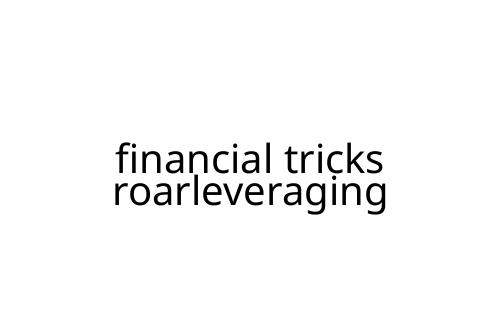financial tricks roarleveraging
Understanding financial tricks roarleveraging can give you a real edge when navigating your personal or business finances. While the term isn’t common in mainstream conversation, the idea is to apply sharp, often overlooked shortcuts and leverage points that help you get more out of the money you already have. Let’s break down what this means, how it works, and whether it really makes sense for you.
What is Financial Tricks Roarleveraging?
At its core, financial tricks roarleveraging is about spotting and exploiting opportunities to amplify your financial position with strategic, sometimes unconventional moves. Think of it as multiplying the impact of your cash flow, credit, or investments—a bit like using a lever to lift more than you otherwise could. It’s not about risky gambling with your money. Instead, it’s about being alert to situations where a small change or clever adjustment brings outsized results.
Popular Roarleveraging Tactics
Some common tactics fall under this approach:
1. Smart Debt Utilization
Not all debt is bad. Using low-interest loans to invest in high-return opportunities (like real estate or a robust side business) can accelerate growth without exposing you to major risk—if you do the math right.
2. Credit Card Rewards and Bonuses
Leveraging rewards programs—cashback, travel points, sign-up bonuses—can add up over time. Just be sure to pay balances in full each month to avoid negating gains with high-interest charges.
3. Tax Optimization
A classic trick: maximize pre-tax retirement contributions or business expenses to reduce your tax burden now and let your savings grow faster over time.
4. Compounding Investments
Roarleveraging is about momentum. Even small, regular contributions to an investment portfolio can grow surprisingly large thanks to compound interest. Starting early is the key.
Pros and Cons
Let’s call it straight—every tactic has its flip side.
Pros:
- Makes your money work harder for you
- Can help build wealth faster
- Often uses existing resources; no need for a windfall
- Accessible for individuals and small businesses alike
Cons:
- Requires discipline and attention; mistakes can be costly
- Some techniques (like credit leverage) increase risk
- Not all opportunities are right for everyone
Tips for Using Financial Tricks Roarleveraging Wisely
- Do the math: Don’t guess—model out the likely outcomes and stress-test your assumptions.
- Watch the downside: Don’t put yourself in a position where one wrong move unravels everything. Conservative leverage can be powerful; reckless leverage is a one-way ticket to trouble.
- Stay informed: Keep up with new options—credit card offers change, tax rules evolve, and investment products come and go.
- Stick to the plan: Don’t chase every “trick.” Focus on those that match your goals and risk tolerance.
Final Thoughts
Financial tricks roarleveraging isn’t some magic hack—there’s no shortcut to building real wealth. But understanding leverage points, whether in credit, investment, or everyday spending, does put more tools at your disposal. The smart move is to test ideas, stay disciplined, and always watch your downside. Used right, these strategies can help you reach your financial goals a little faster, and with more control.


 Founder & CEO
Irenee Nunezerro is the visionary founder and CEO of Luxe House Maker, with over 15 years of experience in luxury real estate and interior design. Known for her expertise in blending opulence with innovation, Irenee launched Luxe House Maker to provide readers with comprehensive updates on the latest trends in high-end properties, interior décor, and smart home technology. Her passion for creating luxurious, technologically advanced spaces has positioned Luxe House Maker as a leading resource for those seeking to elevate their lifestyles. Irenee’s commitment to delivering cutting-edge content ensures that Luxe House Maker stays at the forefront of the luxury market.
Founder & CEO
Irenee Nunezerro is the visionary founder and CEO of Luxe House Maker, with over 15 years of experience in luxury real estate and interior design. Known for her expertise in blending opulence with innovation, Irenee launched Luxe House Maker to provide readers with comprehensive updates on the latest trends in high-end properties, interior décor, and smart home technology. Her passion for creating luxurious, technologically advanced spaces has positioned Luxe House Maker as a leading resource for those seeking to elevate their lifestyles. Irenee’s commitment to delivering cutting-edge content ensures that Luxe House Maker stays at the forefront of the luxury market.
